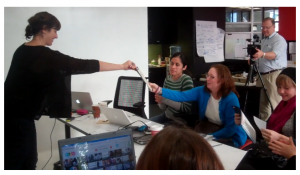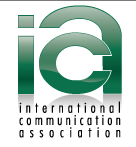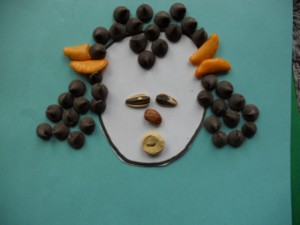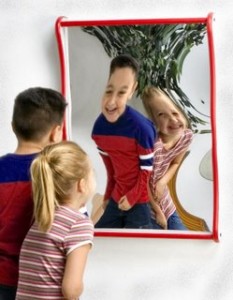 Last year, my PLAY! colleagues and I created, facilitated, and evaluated a two-part professional (PD) workshop for educators of grades 6-12 in the Los Angeles Unified School District (LAUSD).
Last year, my PLAY! colleagues and I created, facilitated, and evaluated a two-part professional (PD) workshop for educators of grades 6-12 in the Los Angeles Unified School District (LAUSD).
The first part was The Summer Sandbox. We designed this intensive one-week workshop for participants to collaboratively explore participatory learning. PLAY! hoped that, by experiencing the rewards of a participatory learning environment first-hand, participants would go on to explore PLAY!’s pedagogy more deeply in their own classrooms and schools. We ran this program two times, over back-to-back weeks. Twenty-one educators from 17 schools and a multitude of disciplines, including social studies, physical education, life sciences and special education, completed the program.
In order to sustain The Summer Sandbox graduates’ implementation of participatory learning, PLAY! offered a PD extension called PLAYing Outside the Box (POTB). Its structure was even less prescriptive than that of the relatively malleable five-day immersion. POTB was conceptualized more as a service than a seminar, intended to scaffold and support participants’ self-directed efforts. Approximately half of The Summer Sandbox graduates enrolled in POTB. These 10 educators hailed from 10 different schools, located up to 20 miles apart, that served student populations whose socioeconomic and developmental profiles varied considerably.
At the end of fall semester, POTB participants met for one last session to share classroom experiences, reflect on personal growth, identify challenges, discuss sustainability, and plan for next steps. We utilized a reflection technique called Most Significant Change (MSC; Davies & Dart, 2005). MSC asks participants to describe their personal experiences of program-produced change and articulate “the significance of the story from their point of view” (Davies & Dart, 2005, p. 26).
While each participant’s experience was unique, three key themes emerged across all the stories:
- surrendering some classroom control in order to honor students’ self-directed learning and creativity;
- embracing technology and digital media even in the absence of personal expertise/mastery; and
- valuing process over product – that is, escaping the tyranny of perfection.
Here are the 10 educators’ reflections:
If Larry were to title the story of his experience, it would be “Challenging Mr. Brown.” An urban high school science teacher in a desk-jammed room filled by students, this self-proclaimed “left-brained” thinker strove just to make ends meet and incorporated any extra elements he could. Allowing his students to explore science terms by making extra credit videos was one of the ways Larry adjusted his curriculum. Larry also stated, “Now I can use more social media in my practice” — no small feat for a former technophobe!
“I use technology more in my classroom,” Katie said to describe her most significant change. Although she is a relatively young teacher with less than 10 years of teaching experience under her belt, Katie revealed that this program motivated her to “update [her] teaching techniques.” When Katie’s biology students were dissecting a flower, she decided to let them use their mobile devices as tools for photography, measurement, etc. The Summer Sandbox’s AnimAction presentation, as well as her participation in that PLAY On! Workshop, also inspired Katie to harness animation as a means for learning and sharing about science. Of this program in general, Katie said, “It’ll make me think about how I can use media more in my classroom.”
The erudite Helen entitled her change narrative “Delving Deeper into Technological Research in Secondary Learning.” Opined Helen, “I think that [her students’ differing preferences for Blogger and the PLAY! platform] only tells us that each individual student is their own individual learner, which we must flesh out and understand in order to enhance the best learning experience.” Helen substantively embraced the PLAY! platform, challenging her high school expository writing students to actually conduct research for their essays and gather text, images, and media to enhance their learning, reading, and writing.
Frank admitted to change in profound ways, calling his story “Breaking Down the Wall.” Explained Frank, “When I first started the project I was interested because it said NML and I thought I knew what it meant. I was totally bombarded by things that I didn’t know but I was very intrigued… Being there [in the Summer Sandbox] resonated this feeling within me, Okay, this is what I should be doing in the classroom… Leaving that summer instruction that we did [the Summer Sandbox], I was excited to try out some of those strategies with the students… I let myself go, where I could just give kids tools, [tell them] ‘This is what you have to create but I’m not going to tell you how to create it.’”
For Frank, the kids in question are middle school students from primarily low-income, Latino backgrounds. Frank confessed, “I forget about the creative side of education. I know that testing’s important for them but at the same time, education should not hinder the creative process. What if I have a future poet in my classroom?” he mused. “The wall [referred to in the title of this change narrative] metaphorically represents the barriers that ironically education builds up for our students because they get categorized.” Frank summed up the job of educators as “enabling the students to break down those walls through different avenues.”
Nancy, a high school social studies teacher with a special interest in human rights, named her story “Letting Go.” Elaborated Nancy, “I would say that the number one most significant change was the idea of just letting go completely. That I can make mistakes and my students can make mistakes and that that is okay. And that it all is a learning process. And that really was — even though I consider my classroom to be open and constructive — I still found that I was sort of controlling and that I was looking for perfection not just in my students but in myself. And this freely allowed me to open up this idea of letting go.”
In her classroom during the school year, Nancy translated this philosophy into practice by “…allowing those rubrics to be more flexible, allowing students to redo, allowing them to, as part of their grade, [explain] what were they frustrated about, what worked, what didn’t work. And so, making the whole process part of the grade, as opposed to [only] the perfected final work product [determining the grade].”
Students’ responses were not universally warm, confided Nancy. “I would say 80% of the students were beyond thrilled… those students who were atypical students, who feel uncomfortable, they fought it a little bit. But overall I think it was a positive experience.”
High school history and government teacher Jasmine dubbed her tale “Giving Voice to the Youth.” Narrated Jasmine, “For me the most significant change was I always liked technology and using it in the classroom. But this year I’ve definitely integrated it more into pretty much every project. In the past I was worried about that I didn’t have all the skills necessary to teach them things or we didn’t have all the equipment or they didn’t have it at home. But I thought, This year, let’s just go for it. And I was open to students participating in whatever way they could.” Jasmine credits this embrace of not only technology but also experimentation and co-learning to the Summer Sandbox. “I think the professional development that we had in the summer was very, very inspiring, because I met so many different teachers and I learned so much about all the things that they were doing in their classroom…”
Subsequently, she modified her curriculum extensively, introducing a project in which students visited the Occupy L.A. encampment and created a PLAY! platform challenge to share out their learning. “Our kids have made songs. They’ve made videos. They’ve done stuff online. And I actually think they’ve learned a lot. This is the first year that, after a unit is over, students come back to it and they’re like, ‘Oh, Miss, did you hear that this happened with Occupy L.A. or on a Facebook page?’ They’ll just post videos and news stories about it and talk about it. And I’m like, ‘Well, that’s cool.’”
Continued Jasmine, “I think that this year my students have definitely gotten more engaged with the world.” A classroom viewing of Chinese documentary Please Vote for Me ignited students’ curiosity. “They said, ‘Can we have our own election?’ I was like, ‘Well, I wasn’t planning on it, but okay, let’s do it…’ And in there I integrated things about campaigning and media, and so we became a class congress, and so they’re learning how bills get passed but by doing it themselves…
“It has involved letting go, and just being very, very experimental. And being okay with it if it’s not perfect. But,” Jasmine smiled, “I think we’re having a really good experience.”
“Becoming Tech Savvy” is the title of language arts specialist Natalie’s account. “Being able to acquire the skills to use different digital tools… being able to navigate various issues that came up… It empowered me, made me feel more confident as an educator in the 21st century because, while I assume that my students know a lot, on the other hand, they don’t, and yet they are very familiar with a lot of what social media is and how it’s what engages them, and so now I feel more equipped to make my instruction relevant to them.” Natalie introduced a unit, called “Voices for Change,” in which students researched, wrote, filmed, and edited public service announcements (PSA’s) on issues of their choosing.
Natalie found herself reflecting on her passions and values alongside her students. “It inspired me to think about what kind of things do I want to change.” But for Natalie, the demystification of technology was her greatest take-away. “I would encourage as many teachers to just keep an open mind, to be willing to make mistakes, to be willing to have fun, know that not everything’s going to work out perfectly, but that’s okay, it’s going to help you to become more proficient.”
Social studies teacher Ziyi disclosed the philosophical and pedagogical shift this program facilitated, expressed in the title, “It’s Okay to Use Technology In Your Classroom. It’s Good For The Kids. It’s Good For Us. It’s Good For Them. It’s Good For Me.” Said Ziyi, “I think the change that’s occurred for me is really personal. In the beginning I had really felt like technology was great and I did not quite see how it would fit into the classroom. In fact, a lot of times I felt like I was sort of like cheating the kids, because we’re having fun instead of really learning… And thank goodness I’ve been involved in this and thank goodness we’re encouraged to allow the students to play with technology and explore and learn different skills.” Subsequently, Ziyi asked her students to modify a Powerpoint by pasting various historical images pertaining to the Industrial Revolution. This assignment allowed her students to practice several NMLs, including judgment, transmedia navigation, and visualization.
The degree to which experiences should be structured (for example, by using templates like the aforementioned Powerpoint) is open for debate and experimentation. More important is Ziyi’s takeaway that play and fun do not prohibit learning. In fact, some research suggests that they are actually prerequisites.
Ken titled his most significant change “Ken Has an Epiphany about How Broader Co-Learning Can Exist Inside My Classroom and Across My Classrooms.” This realization struck during a mandatory, videotaped reflection on the PLAY-rich lesson that he developed and implemented in his classroom (and also videotaped). Per POTB requirements, Ken posted both videos to Vimeo for his peers’ viewing and feedback. He confided in his MSC interview, “…The actual most significant change that I experienced did not take place in my classroom with my students, but it was more of a change in my attitude and expanding my thinking about what can occur with my students in the future. And that is to give them more of an opportunity to have co-learning experiences, not only with other students in their classrooms, but with students in different classrooms as well as even perhaps with students in different schools… [It’s] more of my attitude and my willingness to go beyond what I’ve normally done and kept things in my classroom and move to more co-learning in a broader sense.”
This “co-learning in a broader sense” is what embracing the learning ecosystem is all about. Meaningful learning has always moved beyond classroom silos and harnessed the expertise, inspiration, and on-the-ground reports of those who care – either because their job depends on it, or their curiosity demands it. Allowing, welcoming, even facilitating learners’ access to a broader learning ecosystem is imperative for their acquisition of rich information and lifelong learning skills.
Like so many of his colleagues, Ken also mentioned letting go. Rather than control issues, though, Ken identified fear as his barrier—or former barrier. “I’m willing to be much more brave in using activities such as VoiceThreads in my classrooms whereas before I was much more timid about those types of new technology and their uses and applications in my classroom.” This technological self-efficacy is an important predictor for using various technology in the future.
Attired in a red and white Santa cap, Nanette (perhaps playfully) entitled her change narrative “An Early Christmas Present for Someone.” Because her students have extreme special abilities, Nanette extensively tailors her teaching of academics and functional self-help skills to each student’s cognitive and physical capacities. Certain technologies, Nanette found, can facilitate learning in both domains. For example, she introduced the iPad and “more technological devices” in the classroom due to their relationship with students’ motivation and engagement – “this is what the students are more interested in” – and their practicality. Stated Nanette, touch screens are “more accessible for our students.”
 I’m proud to be a member of the International Communication Association’s Children, Adolescents and the Media Division. Our brilliant leader, Dr. Amy Jordan, today announced that six categories of interest seem to have emerged among members’ proposals for a preconference or extended session on teaching children and media at ICA’s annual conference in London 2013. These are listed below in no particular order:
I’m proud to be a member of the International Communication Association’s Children, Adolescents and the Media Division. Our brilliant leader, Dr. Amy Jordan, today announced that six categories of interest seem to have emerged among members’ proposals for a preconference or extended session on teaching children and media at ICA’s annual conference in London 2013. These are listed below in no particular order:




